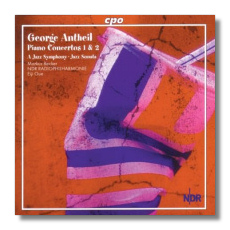
The Internet's Premier Classical Music Source
Related Links
- Antheil Reviews
- Latest Reviews
- More Reviews
-
By Composer
-
Collections
DVD & Blu-ray
Books
Concert Reviews
Articles/Interviews
Software
Audio
Search Amazon
Recommended Links
Site News
 CD Review
CD Review
George Antheil

- Piano Concerto #1
- Piano Concerto #2
- A Jazz Symphony
- Jazz Sonata
- Can-Can
- Sonatina for Radio
- Sonatina "Death of Machines"
- Little Shimmy
Markus Becker, piano
NDR Radio Philharmonic Orchestra/Eije Oue
CPO 777109-2 65:38
The works on this CD were written in the 1920s and 30s when George Antheil – the so-called "Bad Boy of Music" – was exciting and scandalizing New York City, Paris, and Berlin with his creations. (The most famous of these, the Ballet mécanique, calls for a phalanx of pianos or pianolas, and an airplane motor.) Apart from being a composer, Antheil was a fine if apparently somewhat idiosyncratic pianist. He had other skills too: he wrote a book for laymen on forensic endocrinology and a newspaper column containing advice for the lovelorn. With actress Hedy Lamarr, he invented a successful radio-controlled torpedo!
The CPO label has been releasing recordings of Antheil's symphonies for a few years now, and it is nice to see them turning their attention to the two piano concertos, even if they don't quite live up to the composer's hopes for them. The first concerto, written in Berlin and premièred in 1922, wears the influence of Stravinsky on its sleeve, even down to the inclusion of several nearly exact quotes from Pétrouchka. About 20 minutes in length, it is in a loosely organized single movement. Antheil doesn't develop his ideas as much as he brings them on stage one after the other, although there are some repeated ideas that lend the work a semblance of structure. With music like this, it's best to fasten your seatbelt and to let it take you for a ride.
The second concerto was premièred in Paris in 1927. It confounded the expectations of the Parisians who thought they had figured out what George Antheil was all about, and it was not a success. About as long as the first concerto, it is divided into the traditional three movements. Again, Antheil is not particularly interested in developing his material, but the shorter movements help to make the concerto seem less episodic. Traces of Stravinsky's influence remain, but the dominant element is a semaphoric sort of neoclassicism. As Eckhardt van den Hoogen writes in his typically baroque booklet notes, "the 'neoclassicism' of this project has the effect of a caricature in which thematic physiognomy has been forgotten for the sake of principles." In other words, the music is a series of calculated gestures. Despite the superficial resemblances to popular musical idioms, its affect is decidedly (but fascinatingly) cool.
A Jazz Symphony, originally written for W.C. Handy's orchestra, was premièred in 1927 at the same concert as the Ballet mécanique. In 1955, four years before his death, Antheil arranged it for a more conventional orchestra, and it is that arrangement which is heard here. This eight-minute "symphony" is a toe-tickling and enjoyable exploration of ragtime and early jazz rhythms. It has nothing to do with improvisation, however, which is the cornerstone of jazz.
The remaining works on this CD are brief works for solo piano. The Jazz Sonata shares ideas with the Jazz Symphony. Can-Can is a fragment from an otherwise forgotten ballet. The Sonatina, dedicated to Aaron Copland, is as skeletal as the Piano Concerto #2. Death of Machines (his Third Piano Sonata) might he interpreted as the other side of Antheil's fascination with gizmos, as witnessed not just in the Ballet mécanique but also in the Airplane Sonata. Little Shimmy is a dour, secretive dance. It closes this CD on just the right note.
Markus Becker plays the solo and concertante works with appropriately brittle precision, even irony. In the Jazz Sonata he even pulls off the difficult feat of sounding like a pianola. Oue and the Hannover-based NDR Radio Philharmonic mirror Becker's subtle detachment… or is it Antheil's music itself which is subtly detached? Fine engineering, and as suggested above, more than comprehensive booklet notes.
Copyright © 2006, Raymond Tuttle




















